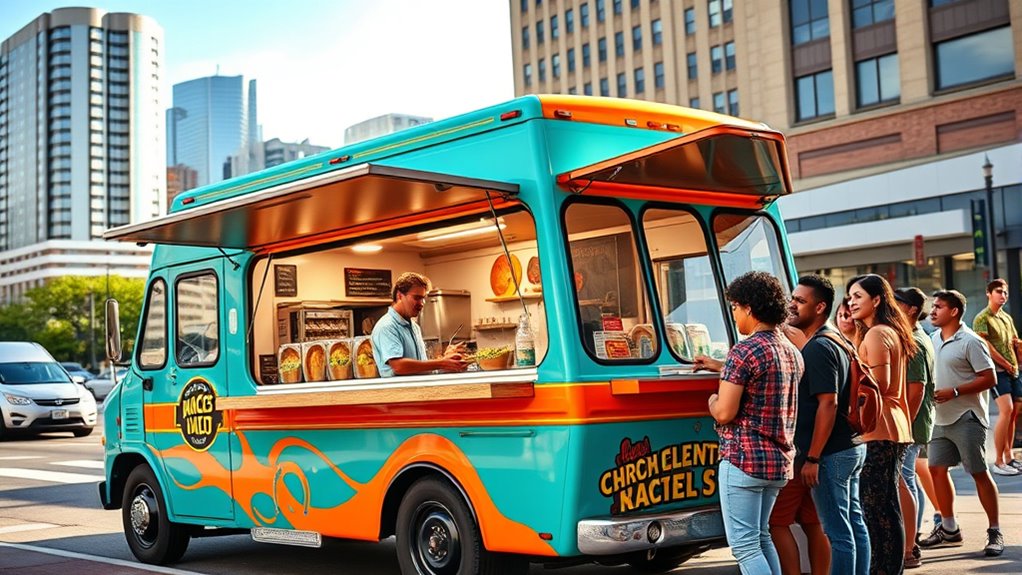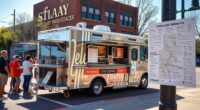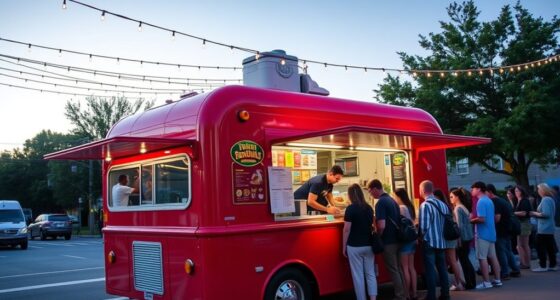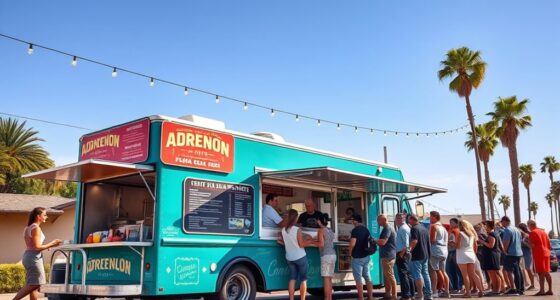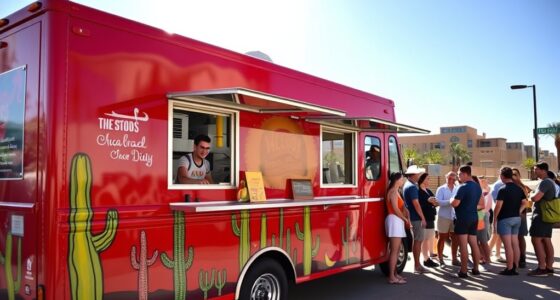To start a food truck in Grand Rapids, MI, you need to understand local regulations, obtain permits, and choose a compliant base for your operations. Develop a menu that highlights Michigan flavors, stay within budget, and secure financing or grants. Focus on strong branding, engaging customers through social media, and partnering with local events. If you keep exploring, you’ll find the key steps to launching and growing your food truck success in Grand Rapids.
Key Takeaways
- Comply with Grand Rapids’ local permits, health regulations, and parking requirements through the city’s online application portal.
- Choose a compliant food truck base, consider shared kitchens for cost savings, and design an efficient kitchen layout.
- Develop a menu featuring Michigan flavors with locally sourced ingredients, and set competitive pricing to ensure profitability.
- Implement modern marketing strategies like social media, contactless payments, and community collaborations at local events.
- Secure proper insurance coverage, explore small business grants, and plan your startup budget for vehicle, permits, and equipment costs.
Food Scene in Grand Rapids
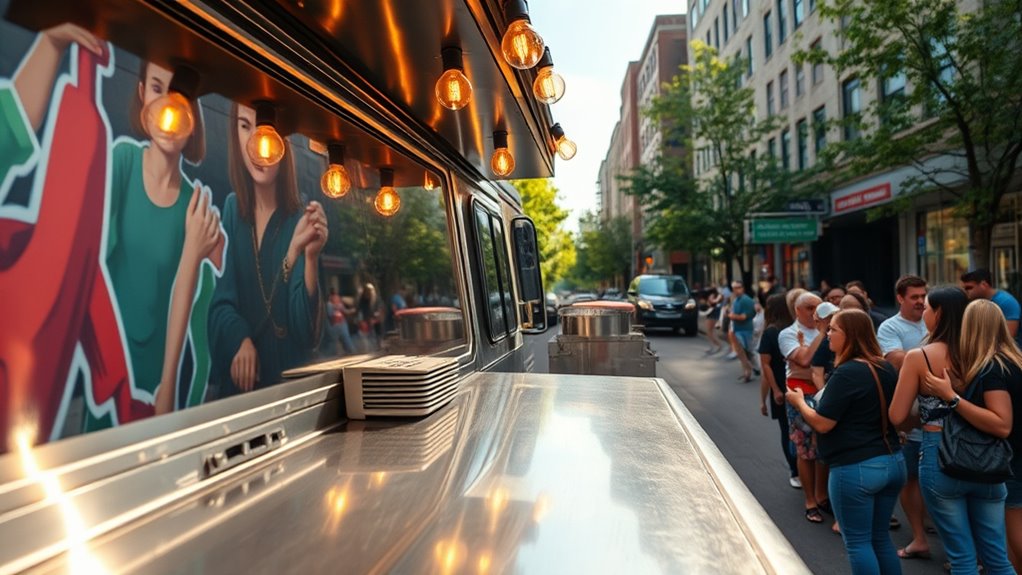
Have you ever wondered what makes Grand Rapids’ food scene stand out? It’s the vibrant mix of local flavors, innovative chefs, and a community enthusiastic to support small businesses. When it comes to food truck branding, standing out with a memorable logo and engaging presence helps attract attention. Building customer loyalty is key here; regulars appreciate consistency, quality, and friendly service. Word of mouth spreads quickly in this active food scene, boosting your reputation. The city’s diverse palate means you can experiment with unique dishes that resonate locally. By focusing on strong branding and fostering relationships, you’ll create a loyal customer base that keeps coming back. This approach ensures your food truck becomes a staple in Grand Rapids’ dynamic culinary landscape. Incorporating community engagement can further elevate your presence and foster lasting connections with your customers.
Understanding Local Requirements

To get started, you’ll need to navigate the online permit application portal to guarantee your food truck meets all local regulations. You must also follow sanitation protocols and keep proper records to stay compliant. Additionally, familiarize yourself with designated street parking zones to avoid fines and ensure smooth operations. Incorporating local dining customs into your setup can also enhance your food truck’s appeal and success in the community.
Online Permit Application Portal
Guiding the online permit application portal is a crucial step in ensuring your food truck meets Grand Rapids’ local requirements. Through this digital application, you can submit your online permit efficiently. The portal streamlines the process, saving you time and reducing paperwork. Before starting, review the necessary documents and requirements listed on the portal. Make sure your application is complete to avoid delays. The portal also provides helpful resources and updates on your application status. Remember, submitting an accurate digital application is essential for compliance. Here’s a quick overview:
| Step | Action |
|---|---|
| 1 | Access the online permit portal |
| 2 | Complete and submit your digital application |
| 3 | Track your application status |
Sanitation Protocols and Record Keeping
Ensuring proper sanitation is essential for compliance with Grand Rapids’ health regulations and for maintaining customer trust. You must follow hygiene standards strictly and keep detailed records to demonstrate compliance. Proper record management includes tracking cleaning schedules, temperature logs, and food safety checks. You should:
- Regularly sanitize food contact surfaces
- Maintain logs of cleaning and sanitation procedures
- Monitor and record refrigerator and cooking temperatures
- Keep documentation of staff hygiene training
- Store all records securely for inspection
Adhering to these protocols helps prevent contamination and ensures your food truck stays in line with local requirements. Accurate record keeping not only simplifies inspections but also improves overall hygiene standards, safeguarding your reputation and customers’ health.
Designated Street Parking Zones
Understanding designated street parking zones is essential for legally operating your food truck in Grand Rapids. Local parking regulations specify where trucks can park, ensuring you don’t violate street zoning laws. Before setting up, review city maps and signage to identify approved parking areas. Some zones may restrict parking times or require permits, so always check for posted restrictions. Complying with street zoning helps avoid fines or towing. It’s also wise to coordinate with city officials if you’re considering temporary or special-event parking. Being familiar with these regulations allows you to operate smoothly and avoid disruptions. Staying informed about parking rules ensures your food truck remains compliant, safe, and accessible to customers while respecting the city’s street zoning policies.
Setting Up Your Base of Operations

Choosing the right base of operations is vital for your food truck’s success. You’ll need to contemplate shared kitchen licensing options and how to design a custom kitchen layout that fits your needs. Let’s explore how to select a space that meets local regulations and maximizes efficiency. Incorporating digital literacy programs can also help streamline communication and management of your food truck business.
Shared Kitchen Licensing Options
Setting up your food truck’s base of operations often involves exploring shared kitchen licensing options, which can offer a cost-effective and flexible solution. These shared kitchens provide licensed spaces where you can prepare your food without the expense of building your own facility. When considering licensing options, shared kitchens typically handle health inspections and licensing compliance, simplifying your process.
Here are some benefits:
- Reduced startup costs
- Access to professional-grade equipment
- Flexible rental hours
- Assistance with licensing and permits
- Opportunities for networking with other food entrepreneurs
Using a shared kitchen can streamline your setup, ensure you meet health standards, and get you on the road faster. It’s a practical choice for new food truck owners looking to establish a compliant and efficient base of operations.
Custom Kitchen Layout Considerations
Designing a custom kitchen layout for your food truck is essential to maximizing efficiency and ensuring smooth operations. Your layout design should prioritize the flow between kitchen equipment, reducing unnecessary movement and saving time during busy service hours. Consider how appliances like grills, fryers, and prep stations will fit together seamlessly within your space. Think about placement to minimize cross-traffic and maintain safety standards. Make certain that your kitchen equipment is positioned for easy access and top-notch functionality, keeping everything within reach. Proper layout design also involves accounting for ventilation, storage, and cleaning areas. By carefully planning your kitchen setup, you’ll create a streamlined workspace that boosts productivity and allows you to serve customers quickly and efficiently.
Budgeting and Financing Your Food Truck
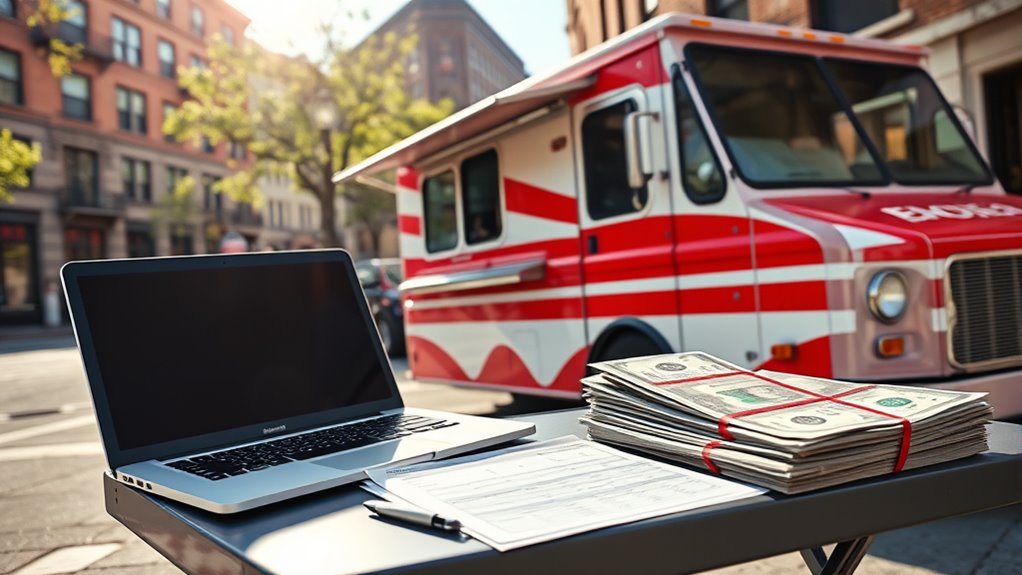
To get your food truck rolling, you need to plan your budget carefully, starting with the initial vehicle costs. Explore local small business grants that can ease some of your financial burdens, and don’t forget to factor in liability coverage to protect your investment. Setting a solid financial foundation now helps ensure your food truck business in Grand Rapids gets off to a strong start. Additionally, researching best financing options can help you secure the funds needed for startup costs and sustain your business in the long run.
Initial Vehicle Purchase Costs
Are you prepared for the initial vehicle purchase costs when starting your food truck in Grand Rapids? These costs can vary widely depending on whether you opt for vehicle financing or equipment leasing. Typically, a reliable used truck costs between $20,000 and $60,000, while a new one can range from $80,000 to $150,000. To manage expenses, consider these options:
- Vehicle financing with manageable monthly payments
- Equipment leasing to reduce upfront costs
- Buying a used truck for affordability
- Customizing your truck to fit your menu and brand
- Budgeting for additional modifications and permits
Being strategic about your vehicle purchase helps keep costs manageable and ensures you start with a solid foundation for success. Carefully evaluate your financing options to make the best choice for your business.
Local Small Business Grants
Ever considered how local small business grants can help fund your food truck in Grand Rapids? These grants can ease your financial burden and boost your startup confidence. Securing small business grants isn’t easy, but with effective grant application tips, you improve your chances. Be thorough, clear, and passionate in your proposal. These grants often cover equipment, permits, or marketing costs, making them invaluable.
Here’s a quick emotional snapshot:
| Challenge | Opportunity |
|---|---|
| Limited startup funds | Access to essential funding |
| Navigating complex applications | Gaining confidence and knowledge |
| Uncertainty about approval | Turning dreams into reality |
Use these grants as a stepping stone—your food truck dreams are within reach!
Liability Coverage for Food Trucks
Liability coverage is a essential part of budgeting and financing your food truck, as it protects you from potential legal and financial risks. Securing liability insurance ensures you’re covered in case of accidents, property damage, or injuries involving your truck. Proper risk management through liability coverage helps you avoid devastating out-of-pocket costs and legal disputes. When planning your budget, consider these key points:
- Understand the different types of liability insurance available
- Assess the potential risks specific to your food truck operation
- Obtain coverage that aligns with local regulations in Grand Rapids
- Factor insurance costs into your overall startup budget
- Regularly review and update your liability coverage as your business grows
Designing Your Menu and Pricing Strategy
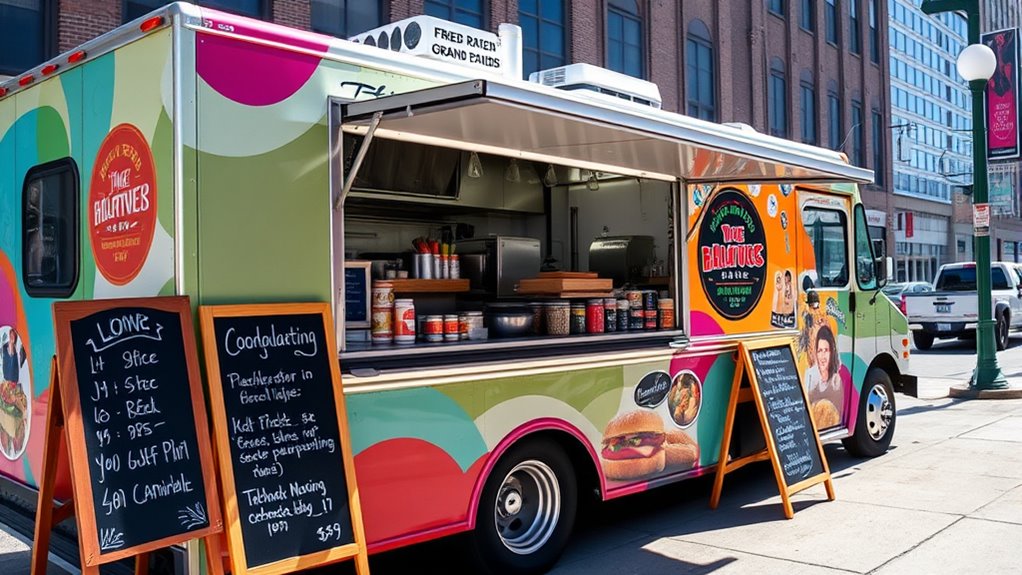
To attract customers, focus on creating a menu that highlights local flavors unique to Grand Rapids. Make sure your prices balance affordability with healthy profit margins. By carefully selecting ingredients and portion sizes, you can maximize value for your customers and your business.
Locally Inspired Menu Curation
Creating a locally inspired menu is essential for standing out in Grand Rapids’ vibrant food truck scene. By focusing on regional flavor integration, you appeal to both locals and visitors craving authentic tastes. Your menu should highlight Michigan ingredients and culinary traditions, setting your truck apart. Consider offering dishes like cherry-glazed ribs, Michigan apple salads, or craft beer-infused snacks. To craft your menu effectively, think about:
- Sourcing ingredients from local farms
- Incorporating regional recipes and flavors
- Offering seasonal specials
- Balancing classic favorites with innovative twists
- Pricing strategically based on ingredient costs and local competition
This approach not only celebrates Grand Rapids’ rich food culture but also helps you build a loyal customer base enthusiastic for unique, regionally inspired dishes.
Optimizing Menu Margins
Designing your menu and setting the right prices are essential steps to maximize profit margins while keeping customers satisfied. Focus on menu pricing strategies that reflect ingredient costs while remaining competitive. Calculate the true cost of each dish by including ingredient costs, prep time, and overhead. To optimize margins, price items so you’re covering costs and achieving a healthy profit, but avoid overpricing which can deter customers. Consider offering a mix of high-margin options and popular items to boost overall profitability. Regularly review ingredient costs and adjust menu prices accordingly to maintain margins. Streamlining your menu by removing low-margin dishes also helps increase overall profitability. By balancing menu pricing with ingredient costs, you ensure your food truck remains financially sustainable and appealing to customers.
Technology and Operations
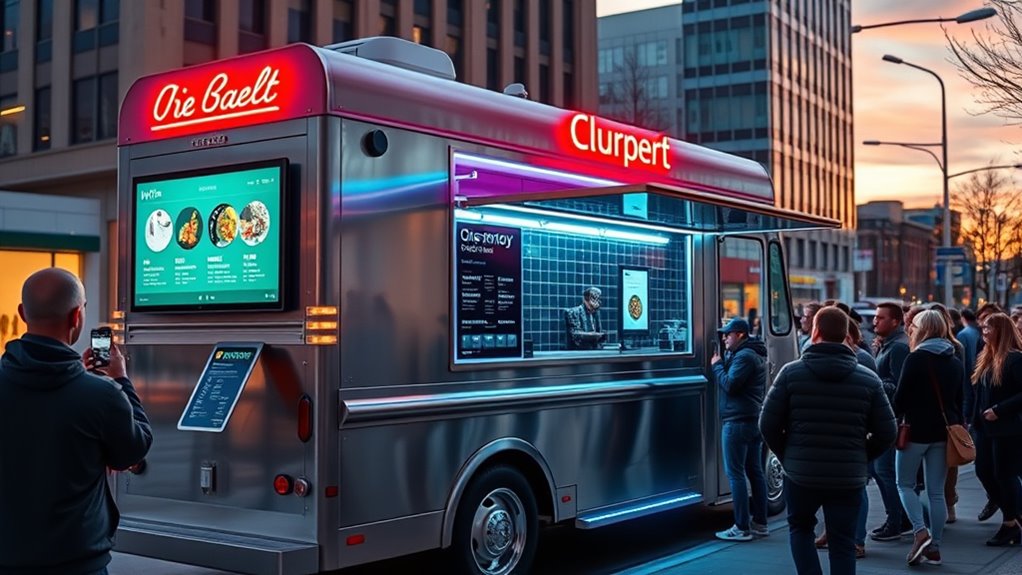
Using mobile payment options like QR codes makes transactions quick and contactless for your customers. Real-time stock tracking software helps you stay on top of inventory and avoid shortages. Incorporating these technologies streamlines your operations and keeps your truck running smoothly. Implementing efficient stove decor ideas can also enhance your food truck’s ambiance and attract more customers.
Mobile Payment Options With QR Codes
Ever wondered how to streamline your payment process and reduce cash handling? Mobile payment options with QR codes make it easy. With simple QR code setup, your customers can scan and pay instantly, enabling contactless payments that speed up transactions. This not only enhances customer experience but also minimizes handling cash and reduces errors. To get started, consider these benefits:
- Easy QR code setup for quick deployment
- Secure contactless payments for customer safety
- Faster checkout times, increasing sales
- Reduced cash handling and reconciliation
- Compatibility with smartphones and tablets
Implementing QR code payments makes your food truck more efficient and modern, ensuring you stay competitive and meet customer expectations for seamless transactions.
Real-Time Stock Tracking Software
Implementing real-time stock tracking software is essential for keeping your food truck operations efficient and responsive. It streamlines inventory management by providing instant updates on ingredient levels, helping you avoid shortages or excess stock. With this technology, you can monitor stock levels as sales happen, enabling better stock optimization. You’ll know exactly when to reorder supplies, reducing waste and ensuring fresh ingredients for your menu. Real-time tracking also helps identify slow-moving items, allowing you to adjust offerings or promotions accordingly. This system minimizes manual counting and errors, saving you time and effort. Overall, it enhances your ability to make data-driven decisions, keeps your inventory organized, and ensures smooth daily operations. Investing in this software sets a strong foundation for a successful, well-managed food truck.
Marketing and Growing Your Presence
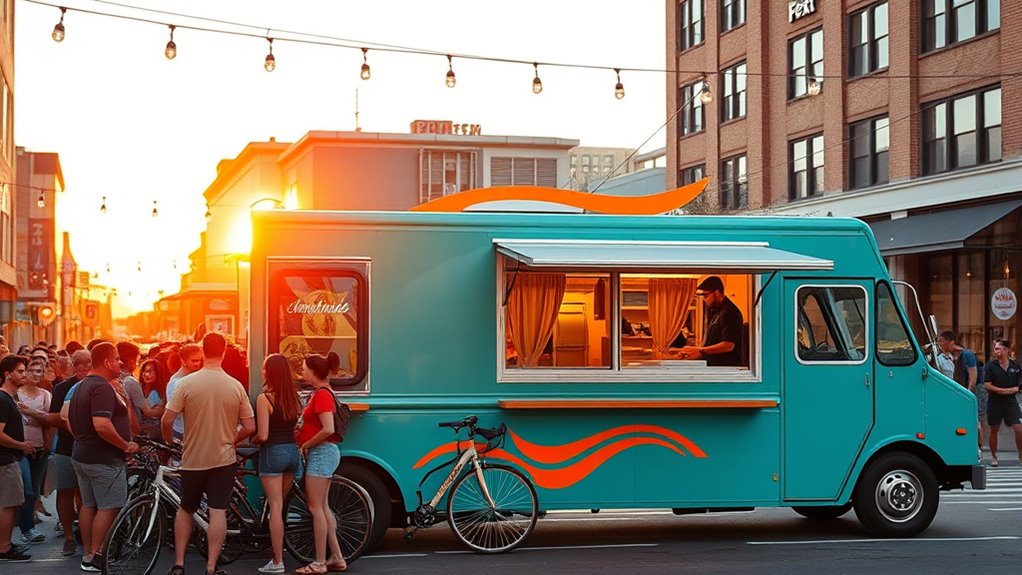
To boost your food truck’s presence, start by planning your weekly event calendar to reach different crowds throughout the week. Use engaging Instagram photos of your food to attract followers and encourage visits. Consistently sharing updates and eye-catching images helps build excitement and keeps customers coming back.
Weekly Event Calendar Planning
Creating a well-organized weekly event calendar is essential for building your food truck’s presence in Grand Rapids. A consistent weekly event schedule helps attract regular customers and boosts visibility. To maximize your reach, integrate effective event promotion strategies, such as social media posts and local partnerships. Keep your calendar diverse to appeal to different audiences and guarantee steady foot traffic. Consider these tips:
- Schedule your truck at popular local events or markets
- Coordinate with community organizations for themed days
- Promote upcoming events on social media regularly
- Offer specials or discounts during specific events
- Track attendance to refine your weekly schedule
Engaging Instagram Food Photos
Capturing eye-catching images of your food on Instagram can substantially boost your food truck’s visibility and attract new customers. Focus on food styling to make dishes look irresistible, arranging ingredients thoughtfully and adding garnishes for visual appeal. Utilize lighting techniques such as natural light or soft diffused light to highlight colors and textures, avoiding harsh shadows. Experiment with angles—overhead shots work well for flat lays, while close-ups emphasize details. Consistent filters and branding also help create a cohesive feed. Here’s a quick guide:
| Tips | Details |
|---|---|
| Food Styling | Use fresh ingredients, garnishes, and appealing arrangements |
| Lighting Techniques | Opt for natural light, diffuse if needed, avoid harsh shadows |
| Angles | Overhead for flat lays, close-up for textures |
Master Local Event Partnerships
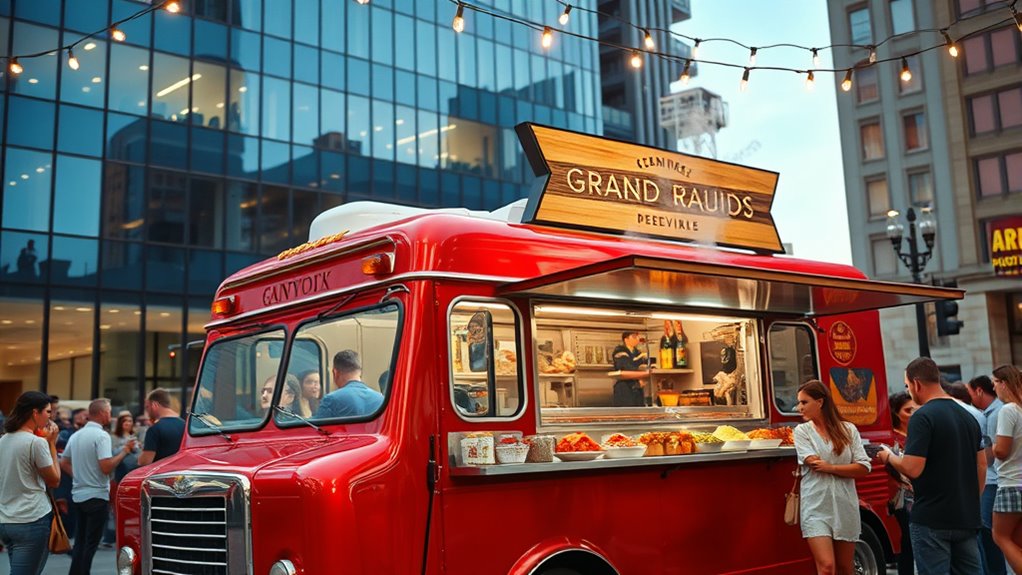
Partnering with local events can considerably boost your food truck’s visibility and sales in Grand Rapids. Building strong community collaborations helps you reach more customers and establish a loyal following. To master local event partnerships, start by identifying popular events that align with your cuisine. Reach out early to secure spot reservations and discuss sponsorship opportunities. Offer exclusive menu items or discounts for event attendees to attract more customers. Collaborate with event organizers to create engaging experiences, like live cooking demos or contests. Consider partnering with other local vendors to cross-promote your brands. Keep a calendar of upcoming events and stay flexible to adapt your offerings. These community collaborations can turn event attendees into regular customers and strengthen your presence in Grand Rapids.
Frequently Asked Questions
Are There Specific Permits for Serving Alcohol From a Food Truck in Grand Rapids?
Yes, you need specific permits to serve alcohol from your food truck in Grand Rapids. You must obtain alcohol licensing and beverage permits from the Michigan Liquor Control Commission and local authorities. These permits guarantee you’re legally authorized to serve alcohol at your events. Be prepared to meet strict requirements, including background checks and inspection processes, to ensure compliance with local and state alcohol laws.
What Are the Best Locations to Park My Food Truck Legally?
You should park your food truck in designated zones that comply with Grand Rapids’ parking regulations. Look for approved areas near busy neighborhoods, events, or popular attractions where street parking is permitted. Always check for signage indicating parking rules and avoid restricted zones to stay legal. It’s smart to contact local authorities or visit city websites for maps of designated zones, ensuring you’re parking legally and attracting customers effectively.
How Do I Find Reliable Suppliers for Ingredients in Grand Rapids?
To find reliable suppliers for ingredients in Grand Rapids, you should connect with local farmers and visit wholesale markets regularly. Attend farmers’ markets and trade shows to build relationships with farmers directly. Additionally, explore wholesale suppliers specializing in fresh, high-quality ingredients. Networking with other food truck owners can also lead to trusted sources. Consistently confirming the quality and reliability of your suppliers ensures you always serve fresh, delicious food.
What Insurance Coverage Is Required for Food Trucks in Michigan?
Think of food truck insurance as your financial safety net, catching you when things go awry. In Michigan, you need food truck insurance that covers liability, property damage, and possibly workers’ comp. Plus, make sure you have the proper Michigan licensing to operate legally. These coverages protect your business, keep you compliant, and give you peace of mind to focus on serving great food. Without them, you’re sailing uncharted waters.
Are There Any Local Food Truck Associations or Networking Groups in Grand Rapids?
Yes, in Grand Rapids, you can join local vendor associations and attend food truck meetups. These groups help you network with other vendors, share tips, and find out about upcoming events. Participating in food truck meetups can boost your visibility and grow your customer base. Look for local food truck groups on social media or community boards to connect with other vendors and stay informed about networking opportunities in Grand Rapids.
Conclusion
Starting your food truck in Grand Rapids isn’t just a business—it’s your ticket to becoming a culinary legend rolling through the city like a flavor-packed tornado. With a solid plan, eye-catching design, and savvy marketing, you’ll turn heads faster than a street performer’s encore. Before you know it, your truck will be the heartbeat of the local food scene, serving up irresistible eats that everyone can’t stop talking about—your empire of deliciousness is just a ride away!
